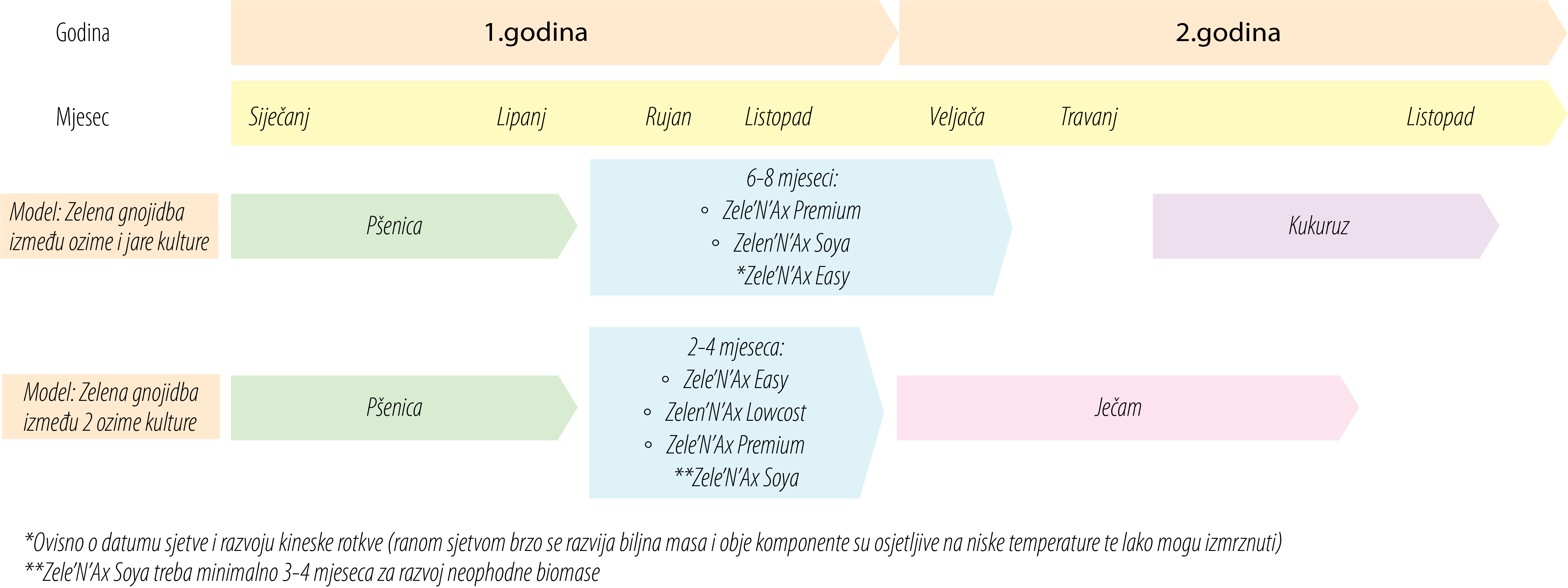Search
Cover crop
Sowing date
The optimal timeframe for sowing green manure is quite broad, ranging from June to late August. Considering that pre-grass is a winter crop, green manure sowing can commence right after the pre-grass harvest. Adequate moisture in the seedbed is crucial for successful sprouting and germination. Sowing early in June not only promotes robust green biomass growth but also facilitates the timely planting of winter crops in the fall.
The sowing date for the green mixture is established according to the crop rotation, which follows two models:
- A green mix of longer vegetation requires 6-8 months for the growth and development of biomass and roots. These overwintering mixtures serve as a catch crop between the winter and spring crops. By allowing this mixture to overwinter, the soil remains covered and protected throughout the winter season.
A green mix of short vegetation requires 2-4 months for the growth and development of biomass, typically utilized between two winter crops. This practice offers numerous benefits:
- It diminishes the build-up of plant diseases in the soil.
- It contributes to a 2-6% increase in yield due to nutrient accumulation.
- It enhances the humus content in the soil.

Sowing technique
1. Direct sowing - No till
Immediately following the harvest of winter crops, when the soil retains sufficient moisture, is the ideal time to sow green manure. It is advisable to maintain a row spacing of 12.5 cm. Occasionally, the tread wheels may not perform adequately, leaving the sowing row exposed. In such cases, replacing the running wheels and adjusting them to the sowing conditions is necessary. An open row can lead to inadequate soil contact for the roots, increasing the risk of plant desiccation. Sowing directly into compacted soils may result in weaker seedling emergence and suboptimal crop establishment. We highly endorse this technique.
2. Sowing after shallow soil preparation - Seeder or spreader for mineral fertilizer
Shallow planting can be performed immediately after harvesting, or you can allow wild sorghum to sprout and then destroy it with a plate. Sowing the green mix into soil prepared in this manner ensures optimal seed-to-soil contact, promoting the best germination and growth. If sowing occurs under dry conditions, germination will be postponed until the next substantial rainfall. We highly recommend this technique; however, it involves an additional operation that increases costs compared to direct seeding.
Sowing with a mineral fertilizer spreader
Using a broadcast spreader for sowing is a cost-effective and swift method, though it lacks the precision of the aforementioned technique. Shallow soil preparation is essential for proper seed placement. Often, the seed mix contains various seed sizes, necessitating an adjustment of the spreading distance. Sowing with a spreader risks leaving seeds on the soil surface, leading to poor root development and weaker growth.
Sowing depth
The depth of sowing is largely determined by the size of the seeds in the mix. When the mix includes seeds of varying sizes, it's essential to calibrate the sowing depth to the average size of the seeds in the mixture.
Grain size | Sowing depth (cm) | Our mixtures | Sowing depth (cm) |
Fine grains | 1-2 | Zele’N’AX Easy | 1,5 |
Coarse grains | 2-3 | Zele’N’AX Premium | 1,5-2,5 |
A blend of coarse and fine grains | According to the average grain size | Zele’N’AX Lowcost | 1,5
|
|
| Zele’N’AX Soya | 2 |
Destruction of green manure biomass
The purpose of green manuring is to cultivate a substantial above-ground biomass and root system that enhances soil structure. The elimination of this biomass and roots can occur through natural, mechanical, or chemical means. It is crucial to carry out this process before the plants flower to prevent the dispersal of seeds and subsequent reproduction.
Natural Destruction:
- Freezing - Certain plant species can easily succumb to freezing at temperatures just below 0°C, while others are more tolerant of cold and survive the winter with ease. Select the appropriate mix based on your crop rotation plan.
Mechanical Destruction:
- Rolling During Frost - Some plants in the mix may need a frost deeper than -10°C to fully freeze the biomass. However, in milder frost conditions, rolling the biomass can expedite destruction. This method is cost-effective.
- Rolling Fresh Biomass - The most effective results come from using a Cambridge roller. For enhanced effects, a short disc harrow can be used for shallow tillage.
- Tarping Fresh Biomass - This operation is beneficial but requires more fuel.
- Plowing - While effective for biomass and root destruction, it contradicts the purpose of green manure, which is to enhance soil structure and alleviate soil compaction, goals unattainable if crop residues are plowed under.
Chemical Measures:
- Chemical treatments are highly effective but should be considered a last resort.
After the biomass has been cleared, you can begin preparations for the subsequent crop:
- For a winter crop - you may proceed with sowing preparations immediately, without the need to wait for the mineralization of the crop residues.
- For a spring crop - it is advisable to start soil preparation at least one month prior to the intended sowing date.
For additional details regarding technology and green manure, please don't hesitate to reach out to our team.

